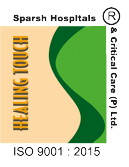Why Sparsh Hospital is your best choice for Arthroscopy & Joint Replacement?

Sparsh Hospital is a leading choice for arthroscopy and joint replacement due to our exceptional surgical team, advanced technology, and patient-centered care. Our surgeons are experts in minimally invasive arthroscopic procedures and complex joint replacements, ensuring you receive the highest standard of treatment. With state-of-the-art facilities and a focus on individualized care plans, Sparsh Hospital is dedicated to helping you regain mobility and improve your quality of life with the utmost precision and compassion.
Understanding Arthroscopy & Joint Replacement
Arthroscopy is a minimally invasive surgical procedure used to diagnose and treat joint problems. It involves inserting a small camera, called an arthroscope, into the joint to visualize, diagnose, and treat various conditions. Joint replacement, on the other hand, involves replacing damaged joints with prosthetic components. This surgery is often performed on knees, hips, and shoulders to relieve pain and restore function. Understanding these procedures can help patients make informed decisions about their treatment options.

Common Arthroscopy & Joint Replacement Conditions and Treatments
Arthroscopy and joint replacement surgeries address several conditions, including:
- Osteoarthritis: Joint replacement to relieve pain and improve function.
- Rheumatoid Arthritis: Arthroscopy to remove inflamed joint tissue.
- Meniscus Tears: Arthroscopic repair of torn knee cartilage.
- Rotator Cuff Tears: Arthroscopic surgery to repair shoulder injuries.
- Hip Dysplasia: Hip replacement to correct joint deformities.
These procedures aim to alleviate pain, restore mobility, and enhance the overall quality of life for patients suffering from joint-related issues.
Diagnostic Tests in Arthroscopy & Joint Replacement
Accurate diagnosis is key to effective treatment. Common diagnostic tests in arthroscopy and joint replacement include:
- X-Rays: Visualize bone structures and detect joint damage.
- MRI: Provides detailed images of soft tissues, including ligaments and cartilage.
- CT Scan: Cross-sectional images for a comprehensive view of joint structures.
- Ultrasound: Real-time images of soft tissues and fluid in joints.
- Joint Aspiration: Analysis of joint fluid to detect infection or inflammation.
These tests help in diagnosing the specific condition and planning the most appropriate surgical intervention.
Arthroscopy & Joint Replacement Treatments
Treatment options in arthroscopy and joint replacement vary based on the condition and patient needs:
- Knee Arthroscopy: Minimally invasive surgery to treat meniscus tears and other knee issues.
- Shoulder Arthroscopy: Repair of rotator cuff tears and other shoulder problems.
- Hip Replacement: Replacement of the hip joint with prosthetic components.
- Knee Replacement: Replacement of the knee joint to relieve arthritis pain.
- Shoulder Replacement: Replacement of the shoulder joint to improve mobility and function.
These treatments are designed to provide effective relief, restore function, and enhance the patient’s quality of life.
Why should I see an Arthroscopy & Joint Replacement Specialist?
Consulting an arthroscopy and joint replacement specialist is crucial if you experience persistent joint pain, reduced mobility, or joint instability. These specialists are skilled in diagnosing and treating a wide range of joint issues using the latest surgical techniques. Early consultation can lead to prompt treatment, reducing the risk of complications and improving your overall health and mobility. Choosing a qualified specialist ensures you receive the best possible care tailored to your specific needs, helping you to return to your daily activities with minimal pain and maximum function.

